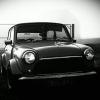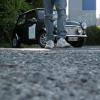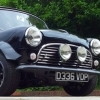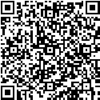
3.44 Final Drive And 13S
#1

Posted 01 August 2012 - 11:23 PM
#2

Posted 01 August 2012 - 11:28 PM
If he knows, tell him that the old 997 cooper had something like a 3.6 diff on 10" wheels....
#3

Posted 01 August 2012 - 11:43 PM
To compare the rolling radius of a wheel/tyre combination do the following:
take the tyre width (e.g 165) and multiply that by 1/100th of the aspect ratio (e.g. 1/100th of 60). Divide the result by 25.4 and add the radius of the wheel.
So for a 165/60 x 12 wheel/tyre, the rollong radius would be:
165 x 0.6 = 99 mm. Divide by 25.4 = 3.9". Add the wheel radius which is 6" anbd the rolling radius is 9.9".
Now do that for a 175/50 x 13 and you get 175 x 0.5 = 87.5 mm. Divide by 25.4 = 3.44" + 6.5" = 9.94" rolling radius.
So the 12" and 13" are almost the same.
A 3.1 FDR will be OK, but a lower FDR, such as a 3.44, would be better for a 998. The original 997 and 998 Cooper had a 3.76 FDR to improve acceleration.
Edited by Cooperman, 01 August 2012 - 11:44 PM.
#4

Posted 02 August 2012 - 12:25 AM
#5

Posted 02 August 2012 - 10:41 AM
The tyre size is unimportant in calculating the gearing, what is important is the rolling radius.
To compare the rolling radius of a wheel/tyre combination do the following:
take the tyre width (e.g 165) and multiply that by 1/100th of the aspect ratio (e.g. 1/100th of 60). Divide the result by 25.4 and add the radius of the wheel.
So for a 165/60 x 12 wheel/tyre, the rollong radius would be:
165 x 0.6 = 99 mm. Divide by 25.4 = 3.9". Add the wheel radius which is 6" anbd the rolling radius is 9.9".
Now do that for a 175/50 x 13 and you get 175 x 0.5 = 87.5 mm. Divide by 25.4 = 3.44" + 6.5" = 9.94" rolling radius.
That will NOT give you the rolling radius, the only way you can measure this is by marking the tire and the ground. Roll the car forward several times, mark the floor again and measure how far between the marks and divide by the number of revolutions you the wheel turned.............
What you are measuring there is the rolling CIRCUMFERENCE. This can be calculated from Coopermans rolling radius as follows:- Diameter x Pi (in other words 2r x 3.1412).
#6

Posted 02 August 2012 - 11:34 AM
#7

Posted 02 August 2012 - 11:56 AM
All "standard" Mini wheels & tyres are similar enough to make much less difference to gearing than final drive swaps.
3.44 is the best all rounder final drive ratio, you certainly wouldn't want anything taller on a 998, unless you're more interested in fuel economy.
#8

Posted 02 August 2012 - 12:14 PM
Now have a 3.44 in my 1275 and that seems much better suited to a mini, 1275 or otherwise.
#9

Posted 02 August 2012 - 12:16 PM
#10

Posted 02 August 2012 - 05:43 PM
If you want the true rolling radius at speed, including centrifugal effects, you probably want a device to count drive shaft or wheel revolutions and an accurate GPS, or just use the tyre manufacturers data, where available. A bit of Googling might find it.
#11

Posted 02 August 2012 - 09:24 PM
What the calculation as I described gives is a fair comparison.
#12

Posted 02 August 2012 - 09:26 PM
#13

Posted 03 August 2012 - 07:29 AM
My ratio calculator http://www.guess-wor.../Tech/ratio.htm uses a similar mathematical formula, which over time has proven to be one of the most useful resources available for both competition and road users in determining gear ratios, final drive and wheel sizes, as well as solutions to the inevitable speedo inaccuracies associated.
#14

Posted 03 August 2012 - 10:56 AM
I think you're confusing accuracy with variability...
When measuring the rolling distance of a wheel, as you do, you are only measuring it for that wheel at that tyre pressure on that car, on that day at that altitude at that temperature, and the list of VARIABLES goes on...
And I would put money on the fact that if you then replaced that wheel with another wheel off the same car and did the measurement again you would get an ever-so-slightly different result.
This is why using a mathematical calculation gives more reliable and comparable results, ok may not be 100% true to real life, but it's near as damn compared to drawing chalk lines on a wheel and the ground and using a tape measure.
#15

Posted 03 August 2012 - 11:13 AM
You're right about the definition and significance of "rolling". Cooperman was also right in his advice of how to calculate the effect of different wheels 'n tyres on gearing.
Anyone reading will have benefited from both posts
1 user(s) are reading this topic
0 members, 1 guests, 0 anonymous users

















